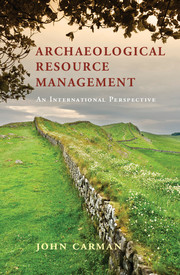8 - Archaeology in the world
from Part III - Conclusions
Published online by Cambridge University Press: 05 September 2015
Summary
The practices of ARM are the primary form of engagement between archaeology and the wider world. This is reflected in the earliest use of the term ‘Public Archaeology’ (McGimsey 1972) to mean what is now referred to as ARM, CRM or CHM, defined as a professional preservationist agenda grounded in law. In attempting to take an international perspective on these practices – an approach that contrasts with the more conventional approaches which describe the specific practices of ARM in individual countries (e.g., Cleere 1984a; Hunter and Ralston 1993; 2006; Smith and Burke 2007; Messenger and Smith 2010; Schofield et al. 2011) – this book ultimately emphasises two key aspects of archaeology. While neither is entirely absent from consideration in the literature, they are rarely considered together and given the status they perhaps deserve as distinguishing features of the discipline.
The first is that archaeology is a practice that takes place in the present. Although related to the past – as an effort to identify and understand material evidence of past lifeways – archaeology is nonetheless a set of activities and ideas that are rooted in modernity (Thomas 2004) and take place in the present, as reflected in discussions of archaeology as a ‘craft’ activity (Shanks and McGuire 1996). An opening focus on the historical development of ARM systems led to the main focus of the book – discussion of the universally recognised core activities of ARM practitioners. In doing so, consideration was given to the kinds of institutions involved in ARM and, by implication, the different kinds of power relations inherent in such professionalised practice, an issue that came to the fore in discussing our relations with various categories of ‘other’. As a contemporary phenomenon, archaeology is deeply implicated in the workings of the modern world, with ‘modernity’ defined as:
a shorthand term for … industrial civilization. Portrayed in more detail, it is associated with (1) a certain set of attitudes towards the world, the idea of the world as open to transformation, by human intervention; (2) a complex of economic institutions, especially industrial production and a market economy; (3) a certain range of political institutions, including the nation-state and mass democracy.
(Giddens 1998, 94)Archaeology reflects these by: providing resources – to the state and its institutions, to educators who mould understandings and to others to construct their own world views – that allow the transformation of the world; offering a systematic and professionalised means for investigating the past; and its status as a state-authorised activity.
- Type
- Chapter
- Information
- Archaeological Resource ManagementAn International Perspective, pp. 185 - 200Publisher: Cambridge University PressPrint publication year: 2015

